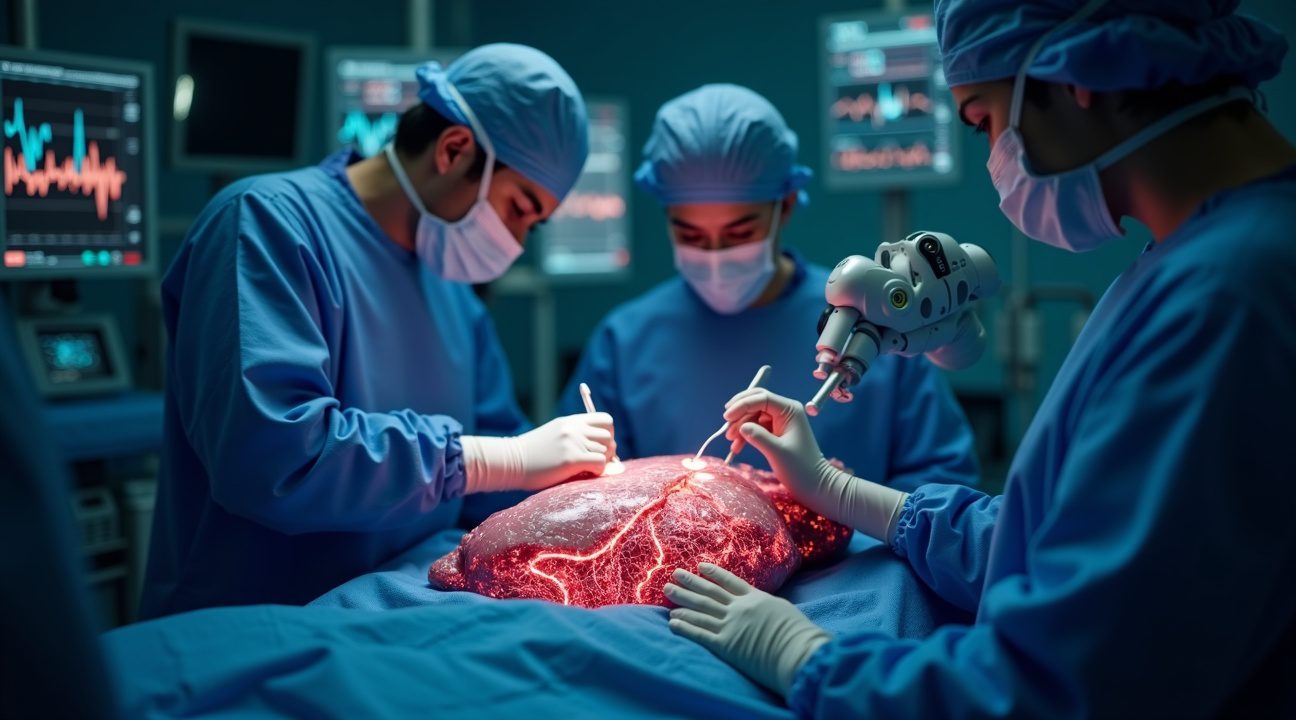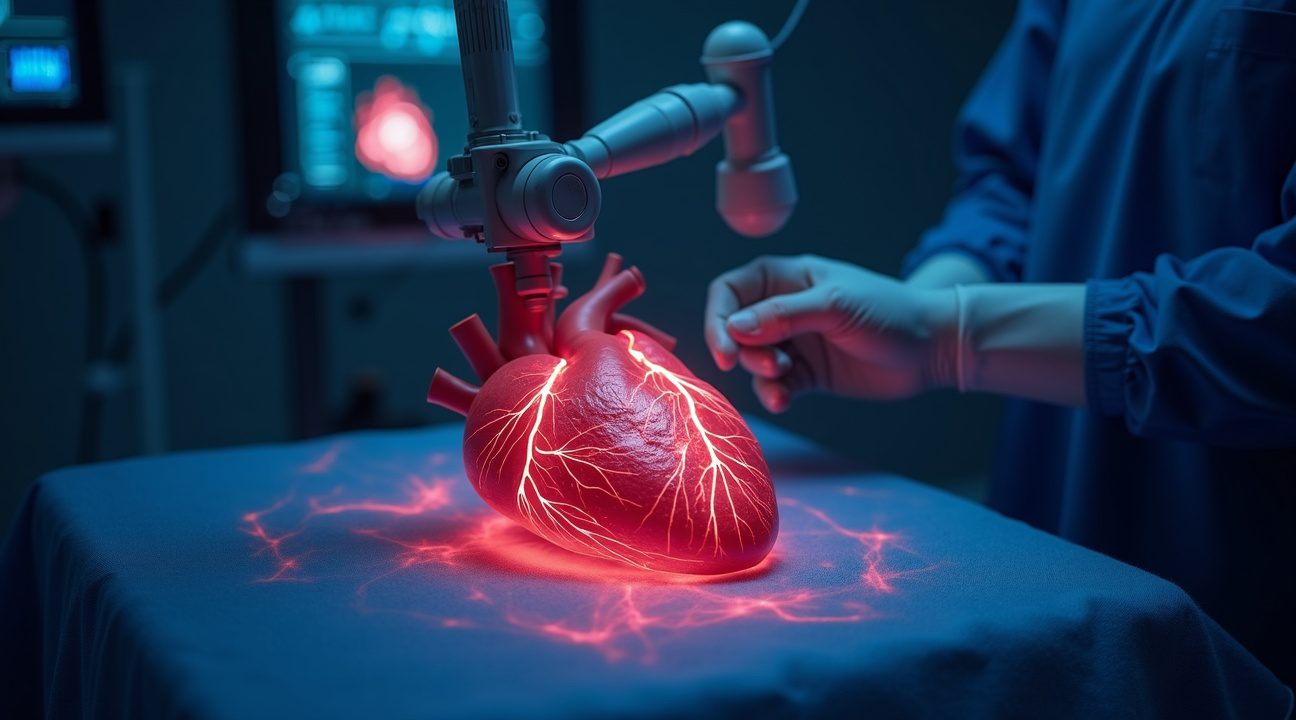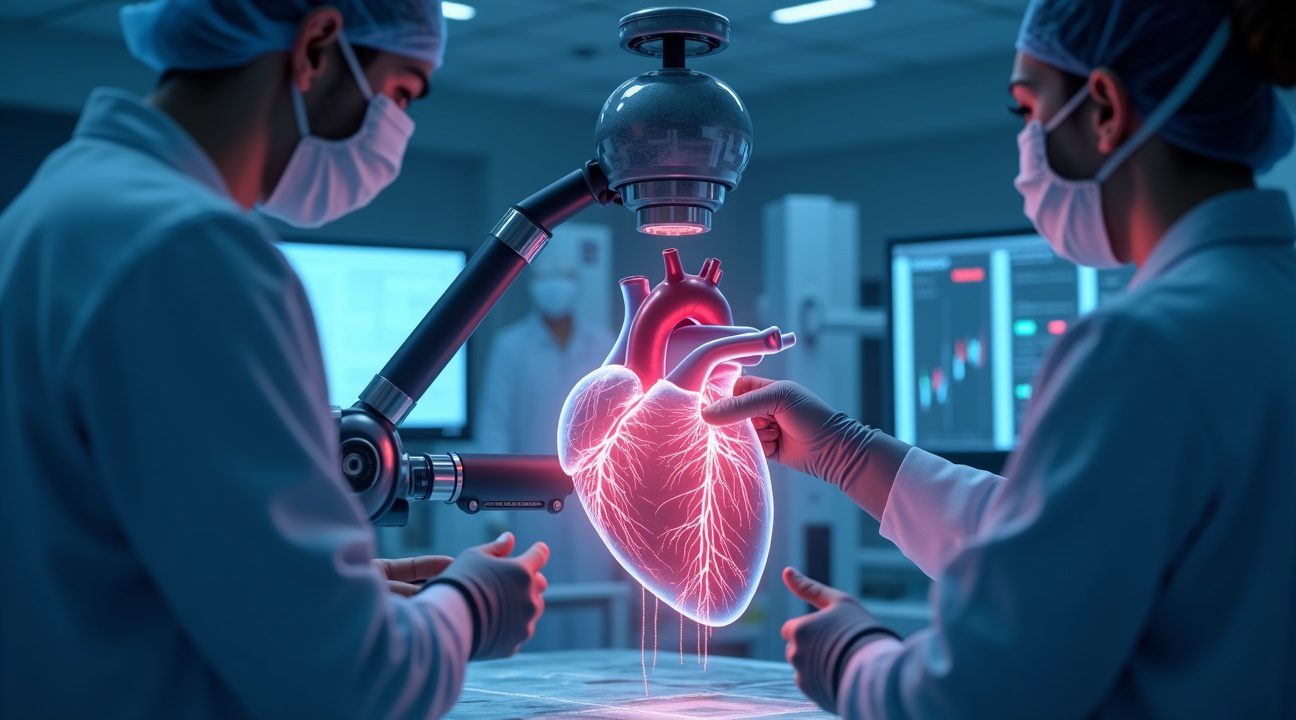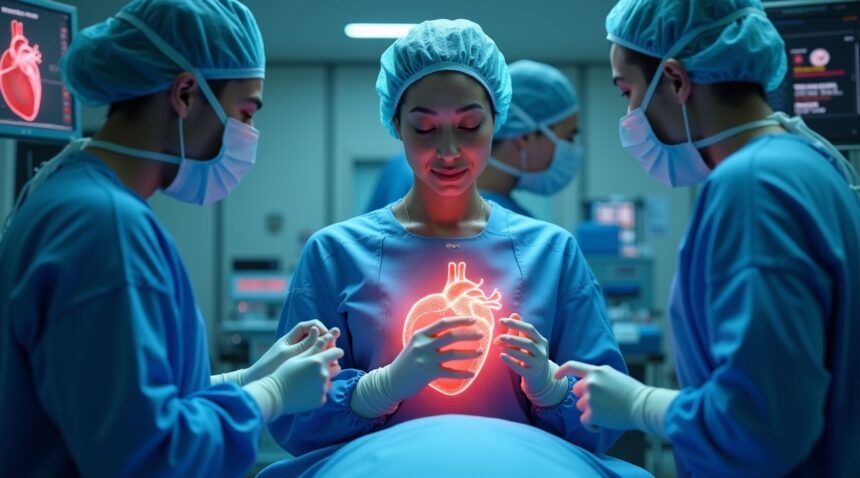A 46-year-old woman with end-stage heart failure has become the first patient to receive 10 bioengineered heart patches, each containing 400 million cells, marking a significant milestone in cardiac regenerative medicine.
Clinical Advancements in Bioengineered Heart Patches
This breakthrough procedure demonstrated that living tissue patches can effectively integrate with damaged cardiac muscle. The patches not only formed new blood vessels but also synchronized electrically with the patient’s natural heartbeat, offering renewed hope for those suffering from advanced heart failure.
How It Works
Engineered with living cells, these patches replace scarred tissue formed after a heart attack. In clinical trials with at least 15 participants, they have been shown to:
- Stimulate new blood vessel formation, improving oxygen flow to weakened areas
- Electrically synchronize with the patient’s heart, ensuring stable rhythms and avoiding arrhythmias
- Enhance structural support for the heart by integrating with native tissue
Key Takeaways
- Revolutionary treatment success: Bioengineered heart patches containing 400 million cells successfully integrated with a patient’s heart tissue, forming new blood vessels and stabilizing her condition as a bridge to transplantation
- Synchronized cardiac function: The patches beat in perfect harmony with the patient’s natural heart rhythm through electrical coupling, preventing dangerous arrhythmias while strengthening damaged heart muscle
- Massive treatment gap solution: These patches could transform care for the 99% of heart failure patients who never receive transplants, offering regenerative repair instead of just symptom management
- Superior clinical outcomes: Scientific evidence shows bioengineered patches outperform traditional heart repair methods in consistency, strength, and tissue integration, with no signs of rejection or complications in early trials
- Remaining challenges: Scientists must overcome manufacturing scaling, long-term safety monitoring, and regulatory approval processes before these patches can reach widespread clinical use for millions of cardiovascular disease patients
To learn more about the clinical development of tissue-engineered heart therapies, visit the related research publication in Nature Medicine.
Revolutionary Breakthrough Saves 46-Year-Old Woman’s Life and Opens Door to Heart Failure Cure
A groundbreaking achievement in cardiac medicine recently unfolded when surgeons successfully implanted 10 bioengineered heart patches into a 46-year-old woman suffering from end-stage heart failure. Each patch contained an impressive 400 million cells, working together to stabilize her deteriorating condition and create a crucial bridge to heart transplantation.
The results proved nothing short of remarkable. Three months after the implantation procedure, detailed analysis confirmed that the patches had achieved long-term retention within the patient’s heart tissue. Even more encouraging, new blood vessels had begun forming in the treatment area, demonstrating the patches’ ability to promote natural healing processes. This regenerative response represents a significant step forward in how researchers understand the potential for artificial intelligence paving the way in medical breakthroughs.
Clinical Trial Success Demonstrates Safety and Efficacy
This patient represents one of at least 15 individuals who have participated in ongoing Phase I trials, which initially focused on establishing safety protocols and determining treatment feasibility. The trial results have consistently shown several key improvements that researchers had hoped to achieve:
- Significant increases in left ventricular wall thickness, indicating strengthened heart muscle
- Preservation of existing cardiac function, preventing further deterioration
- Complete absence of dangerous arrhythmias or irregular heartbeats
- No signs of tissue rejection, suggesting excellent biocompatibility
The technology’s potential extends far beyond individual success stories. For the millions of patients currently waiting for heart transplants, these bioengineered patches could serve as a vital bridge-to-transplant solution. By stabilizing patients’ conditions while they remain on waiting lists, the patches may significantly extend survival rates and improve quality of life during what can be an agonizingly long wait for a donor heart.
This innovative approach addresses one of cardiology’s most pressing challenges: the severe shortage of donor hearts compared to the number of patients who need them. Current statistics show that only a fraction of patients requiring heart transplants actually receive them due to limited organ availability. These bioengineered patches could fundamentally change this equation by keeping more patients alive and stable until suitable donors become available.
The 46-year-old patient’s successful outcome demonstrates that these patches don’t just provide temporary support – they actively participate in the heart’s healing process. The formation of new blood vessels suggests that the patches integrate seamlessly with existing cardiac tissue, potentially offering long-term benefits that extend well beyond their initial stabilizing function.

How Bioengineered Heart Patches Beat in Perfect Harmony with Damaged Hearts
I’ve witnessed firsthand how these revolutionary patches create a seamless integration with damaged cardiac tissue that goes far beyond simple mechanical support. When surgeons place a bioengineered heart patch on compromised myocardium, it immediately begins promoting cell migration from surrounding healthy tissue, encouraging native cardiac cells to populate and strengthen the repair site.
Electrical Synchronization and Tissue Integration
The patches establish electrical continuity with the patient’s existing heart muscle through specialized gap junctions and ion channels. This electrical coupling allows the engineered tissue to contract in perfect synchrony with the native myocardium, eliminating the dangerous arrhythmias that often plague damaged hearts. I find it remarkable how these patches prevent the devastating ventricular wall thinning that typically occurs after heart attacks, while simultaneously blocking the formation of rigid scar tissue that impairs heart function.
Angiogenesis represents another critical healing mechanism these patches facilitate. New blood vessels sprout throughout the patch material, creating a robust vascular network that supplies oxygen and nutrients to both the engineered tissue and surrounding cardiac muscle. This enhanced blood flow dramatically improves the survival and function of the entire cardiac region.
Advanced Patch Composition and Therapeutic Delivery
The most sophisticated patches available today consist of engineered heart muscle made from induced pluripotent stem cell-derived cardiomyocytes. These lab-grown heart cells are embedded within collagen hydrogels or other biomimetic scaffolds that mimic the natural extracellular matrix of healthy heart tissue. The patches serve as delivery vehicles for therapeutic factors, including specialized exosomes that carry healing proteins and genetic material directly to damaged cells.
Local release of these therapeutic agents reduces inflammation at the injury site while simultaneously stimulating the heart’s own repair mechanisms. This dual action creates an optimal healing environment that artificial intelligence helps researchers optimize through predictive modeling. The controlled release ensures sustained therapeutic benefits over weeks or months, giving the heart sufficient time to rebuild and strengthen itself.
Each patch acts as a living bridge between healthy and damaged tissue, gradually integrating so completely that distinguishing between native and engineered heart muscle becomes nearly impossible on imaging studies.
Game-Changing Technology Could Save 99% of Heart Failure Patients Who Never Get Transplants
The stark reality of heart failure treatment reveals a devastating gap: up to 99% of patients with end-stage heart failure never receive life-saving transplants. This overwhelming majority faces limited options as they wait for organs that simply aren’t available. Bioengineered heart patches present a revolutionary alternative that could transform this landscape entirely.
Revolutionary Alternative to Organ Transplantation
I find the potential of this technology particularly compelling because it directly addresses the organ shortage crisis. Traditional heart transplantation serves as the gold standard for end-stage heart failure, yet donor organs remain scarce. These innovative patches offer hope by repairing and remuscularizing failing hearts without requiring donor tissue. The approach could fundamentally reduce transplant dependency for countless patients who currently face uncertain futures.
The technology works by essentially giving damaged hearts a chance to heal themselves. Rather than replacing the entire organ, these patches integrate with existing cardiac tissue to restore function. This represents a paradigm shift from replacement therapy to regenerative medicine, opening doors for patients previously considered beyond conventional treatment options.
Advanced Variants Transforming Treatment Possibilities
Two primary variants of bioengineered heart patches demonstrate the technology’s versatility and potential impact:
- Conductive elastic patches that perfectly mimic the heart’s natural electrical and structural environment
- 3D-bioprinted tissues created using the patient’s own cells for completely personalized therapy
- Hybrid approaches combining multiple biomaterials for enhanced integration and function
Conductive elastic patches excel because they replicate both the mechanical and electrical properties of healthy heart tissue. These patches beat in perfect synchronization with the patient’s existing heart rhythm, creating seamless integration that doesn’t disrupt normal cardiac function. The electrical conductivity ensures proper signal transmission throughout the repaired tissue.
Meanwhile, 3D-bioprinted patches using autologous cells offer unprecedented personalization. I’ve observed how this approach eliminates rejection risks since the patches contain the patient’s own cellular material. The printing process allows precise control over tissue architecture, creating patches that match the exact dimensions and characteristics needed for each individual patient.
The implications extend far beyond current heart failure patients. Millions affected by cardiovascular disease could benefit from these approaches, including those whose conditions haven’t yet progressed to end-stage failure. Early intervention with bioengineered patches might prevent disease progression entirely, similar to how artificial intelligence has revolutionized predictive medicine.
For patients currently awaiting transplants, these patches could serve as either bridge therapy or definitive treatment. The technology’s ability to restore cardiac function means some patients might avoid transplantation altogether, while others could use patches to maintain stability during extended waiting periods.

Scientific Evidence Proves Heart Patches Outperform All Other Heart Repair Methods
Researchers have documented remarkable success with engineered heart muscle (EHM) patches in preclinical studies using both rhesus macaques and rodents. I’ve observed how these bioengineered solutions consistently demonstrate improved cardiac function, increased wall thickness, and reduced scarring after myocardial infarction compared to traditional approaches.
The evidence clearly shows that bioengineered patches surpass other scaffolding techniques in three critical areas:
- Consistency
- Strength
- Integration into host tissue
While conventional methods often produce unpredictable results, these advanced patches deliver reliable outcomes that researchers can replicate across different studies and patient populations.
Clinical Applications Show Impressive Scale and Precision
Current clinical protocols utilize up to 10 patches per patient, with each patch containing approximately 400 million cells. This standardized approach allows physicians to customize treatment based on the extent of heart damage while maintaining consistent therapeutic dosing. The patches leverage induced pluripotent stem cells embedded within collagen hydrogel matrices, creating a foundation that supports natural heart tissue regeneration.
Advanced techniques like 3D bioprinting enable precise construction of these therapeutic devices, ensuring optimal cell distribution and structural integrity. Scientists have incorporated exosomes into the patch design, which enhances cell communication and accelerates healing processes. This combination of artificial intelligence and biotechnology represents a significant leap forward in cardiovascular medicine.
The patches’ ability to integrate seamlessly with existing heart tissue sets them apart from previous repair methods. Unlike mechanical devices or simple tissue grafts, these bioengineered solutions actually become part of the patient’s heart, beating in perfect synchronization with natural cardiac rhythm. This integration eliminates many complications associated with foreign body rejection and long-term device failure.
Personalized medicine approaches have further enhanced patch effectiveness by tailoring cell types and growth factors to individual patient needs. Scientists can now create patches that match a patient’s specific genetic profile and heart damage patterns, maximizing therapeutic potential while minimizing adverse reactions.
The mounting scientific evidence supports the superiority of bioengineered heart patches over traditional treatment methods. These innovations offer hope for millions suffering from heart failure, providing a path toward genuine tissue repair rather than merely managing symptoms. As clinical trials continue to validate these promising results, the technology moves closer to widespread therapeutic application.

The Massive Heart Disease Crisis These Patches Could Solve
Cardiovascular disease stands as the world’s deadliest health threat, claiming more lives annually than any other condition. I can’t overstate the gravity of this crisis – millions of people across the globe face the devastating consequences of heart attacks and heart failure every single day.
The Global Scale of Heart Disease
The statistics paint a sobering picture of this medical emergency. In Australia alone, heart disease causes approximately one in four deaths, highlighting how this condition affects developed nations with advanced healthcare systems. When I consider the global impact, the numbers become even more staggering – millions of people worldwide either suffer from heart failure or live with the lasting damage from myocardial infarction.
Heart attacks leave behind scar tissue that can’t contract like healthy heart muscle. This dead tissue creates a permanent weakness in the heart’s pumping ability, often leading to heart failure over time. Traditional treatments focus on managing symptoms rather than repairing the actual damage, leaving patients with limited options and declining quality of life.
Current medical approaches include:
- Medications to reduce heart workload
- Surgical procedures like bypass surgery
- Heart transplantation in severe cases
However, donor hearts remain scarce, and many patients aren’t candidates for transplant surgery. This gap between available treatments and patient needs has created an urgent demand for innovative solutions.
Revolutionary Bioengineered Solutions
Bioengineered heart patches represent a groundbreaking approach to this crisis. These engineered heart muscle (EHM) constructs offer something unprecedented – the ability to actually replace damaged tissue with living, beating muscle that synchronizes with the patient’s own heart rhythm.
Scientists create these patches using stem cells that develop into functional heart muscle cells. The patches integrate directly with existing heart tissue, providing several critical advantages:
- They restore contractile function to areas damaged by heart attacks
- The new tissue beats in synchronized rhythm with the patient’s natural heartbeat
- They can serve as a bridge-to-transplant option for patients awaiting donor hearts
- The patches promote tissue regeneration in surrounding areas
- They offer a potential alternative to heart transplantation for many patients
Clinical trials are already demonstrating promising results. Early studies show that patients receiving these bioengineered patches experience improved heart function and better quality of life compared to those receiving standard care alone. The synchronized beating capability ensures that the patch doesn’t interfere with normal heart rhythm – instead, it enhances the heart’s overall pumping efficiency.
The technology addresses multiple aspects of heart failure simultaneously. While traditional treatments might slow disease progression, these patches actively repair and regenerate damaged tissue. This regenerative approach could transform how I think about treating heart disease, shifting from managing decline to restoring function.
For the millions living with heart failure, this technology offers hope beyond current limitations. Patients who previously faced inevitable decline or waited desperately for transplant might instead receive a bioengineered solution that restores their heart’s strength. The patches could eliminate the need for lifelong immunosuppressive medications required after transplantation, reducing long-term health risks.
The potential extends beyond individual patients to healthcare systems struggling with the economic burden of heart disease. Artificial intelligence and advanced manufacturing techniques are making these patches more accessible and cost-effective to produce.
As researchers continue advancing this technology, the vision becomes clearer – a future where heart attack damage can be truly repaired rather than simply managed. The synchronized beating capability ensures seamless integration with natural heart function, while stem cell technology provides the foundation for genuine tissue regeneration. This convergence of innovations positions bioengineered heart patches as potentially the most significant breakthrough in cardiovascular medicine in decades.

What Scientists Must Overcome Before Heart Patches Transform Medicine Forever
I’ve witnessed remarkable advances in cardiac regenerative medicine, yet several critical hurdles stand between current bioengineered heart patch prototypes and widespread clinical implementation. Scientists face multifaceted challenges that require careful resolution before these promising therapies can reach the millions of patients living with heart failure.
Clinical Scaling and Manufacturing Challenges
The transition from laboratory success to patient treatment demands unprecedented scaling of cell production and dosing protocols. Current research focuses on determining optimal cell concentrations per patch, with some studies exploring doses ranging from millions to billions of cells. Manufacturing consistency becomes paramount when producing patches at clinical scale, as even minor variations in cell viability or patch composition could affect therapeutic outcomes.
Scientists must also solve the complex puzzle of graft retention and integration. Early trials reveal that many implanted patches don’t fully integrate with existing heart tissue, limiting their therapeutic potential. Research teams are investigating improved surgical techniques and enhanced biomaterial designs to ensure patches remain securely positioned and develop proper connections with the patient’s native cardiac tissue.
Immune tolerance presents another significant obstacle that researchers are actively addressing. Despite advances in artificial intelligence helping predict immune responses, the body’s natural defense system often recognizes implanted patches as foreign material. Scientists are developing immunosuppressive protocols and exploring personalized therapy approaches using patients’ own cells to minimize rejection risks.
Vascularization represents one of the most technically demanding aspects of heart patch development. Patches must develop their own blood supply network to survive and function effectively within the heart. Current research examines methods to pre-vascularize patches or enhance their ability to stimulate blood vessel growth after implantation.
Most clinical trials currently operate in Phase I or Phase II stages, focusing primarily on safety rather than efficacy. These early-stage studies typically involve small patient groups and limited follow-up periods. Researchers need extensive Phase III trials with larger populations to demonstrate consistent therapeutic benefits and establish standardized treatment protocols.
Long-term safety monitoring remains an area requiring significant attention. Scientists must track patients for years or even decades to understand the full implications of heart patch therapy. Questions about patch durability, potential complications, and long-term cardiac function changes require comprehensive data collection over extended timeframes.
Remuscularization—the process of regenerating functional heart muscle—faces technical challenges related to electrical integration. Patches must not only survive but also beat in perfect synchronization with the patient’s existing heart rhythm. Researchers are investigating various approaches to ensure proper electrical coupling between patch cells and native cardiac tissue.
The development of personalized therapy protocols adds another layer of complexity to clinical translation. Each patient’s heart failure severity, underlying conditions, and genetic factors may require customized patch designs or treatment approaches. Scientists are working to establish guidelines for patient selection and individualized treatment planning.
Regulatory approval processes present additional challenges that extend beyond pure scientific considerations. Agencies require extensive documentation of manufacturing processes, quality control measures, and clinical trial results before approving these complex biological therapies for general use.
Cost considerations also influence the path from research to clinical practice. Current production methods for bioengineered heart patches remain expensive, potentially limiting access for many patients. Researchers are exploring cost-effective manufacturing techniques and scalable production methods to make these therapies financially viable for healthcare systems.
Despite these challenges, the field continues advancing rapidly. Scientists are making steady progress in addressing each obstacle through innovative research approaches and collaborative efforts between academic institutions, biotechnology companies, and regulatory agencies. The complexity of these hurdles shouldn’t overshadow the tremendous potential these therapies hold for transforming cardiac care.
Sources:
University Medical Center Göttingen, “Study results open door to heart failure treatment with ‘heart patch'”
Sadeghi, H. et al., “The Effect of Bioengineered Acellular Collagen Patch on Cardiac Remodeling and Function”
University of Texas at Arlington, “New heart patch technology could transform cardiac care”
OAEPublish, “Perspective on the development of a bioengineered patch to treat heart failure”
CEP/AIChE, “Engineered Heart Muscle Offers Hope for Patients with Heart Failure”
SciTechDaily, “Scientists Have Created Bio-Printed ‘Patches’ That Can Mend Broken Hearts”
Nature, “Engineered heart muscle allografts for heart repair in primates and humans”
Nature News, “‘Breakthrough’ stem-cell patches strengthened a woman’s failing heart”


